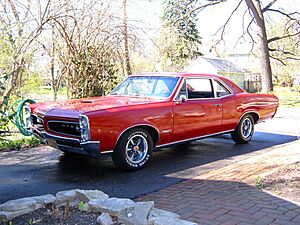Muscle car facts for kids
A muscle car is a special type of American-made car. It usually has two doors and a super powerful engine. These cars were built for exciting, high-performance driving, often on the street or at drag races.
The idea started in 1949 when General Motors put a big, strong engine, called the Rocket V8, into a smaller, more affordable car, the Oldsmobile 88. Before this, such powerful engines were only in luxury cars. This clever idea of combining a big engine with a lighter, cheaper car soon became the "muscle car" style. Other car makers like Chrysler and Ford quickly started doing the same thing.
The name "muscle car" became popular in the mid-1960s. It was used for street cars that were made for performance. Car magazines and advertisements helped spread the term. By the early 1970s, muscle cars included special versions of regular cars. These were designed for both street driving and drag racing. Cars like the 1968 Plymouth Road Runner and Dodge Super Bee were great examples. They had powerful engines in basic, affordable cars. This made them cheaper than fancy models from other companies like the Pontiac GTO or Chevrolet Chevelle.
Some car experts, like those from Car and Driver and Motor Trend, also consider "pony cars" as muscle cars. Pony cars include famous models like the Ford Mustang, Chevrolet Camaro, and Plymouth Barracuda. If these cars had the right high-performance parts, they could definitely be called muscle cars too.
Contents
What Makes a Muscle Car?
It's tricky to agree on one perfect definition for a muscle car. People often debate what truly counts! But here are some common features:
Key Features of Muscle Cars
- Big, Powerful Engine: They almost always have a large V8 engine. This engine is usually the most powerful one available for that car model.
- Rear-Wheel Drive: The engine sends power to the back wheels. This is important for how the car handles and performs.
- Made in the USA: Most muscle cars were built in the United States. They were popular in the 1960s and early 1970s, especially from 1964 to 1973.
- Two-Door Body: They usually have a lighter, two-door body. While some people think only mid-size cars are muscle cars, many experts agree that some high-performance full-size cars, compacts, and pony cars can also be muscle cars.
Some high-powered pony cars are often called muscle cars. Even a few fancy "personal luxury cars" might fit the description. On the other hand, by the late 1960s, some car makers offered very fast, stripped-down cars. These were cheaper and focused purely on straight-line speed. This expanded the idea of a muscle car beyond just style and luxury.
Some people who love drag racing see muscle cars as a modern version of "hot rodding." Hot rodding is about taking a small car and putting a huge engine in it for maximum speed. However, most people, including big car magazines, use a wider definition for muscle cars.
"Supercar" - The Original Name
Did you know that muscle cars were first called "supercars" in the United States? For example, the 1957 Rambler Rebel was described as a "potent mill turned the lightweight Rambler into a veritable supercar." From the mid-1960s to the mid-1970s, many powerful, mid-size cars with big V8 engines and rear-wheel drive were called supercars more often than muscle cars.
By 1966, the "supercar" became a big trend in the car industry. Car companies wanted to make exciting cars that would grab everyone's attention. For instance, a magazine called Car Life reviewed the Pontiac GTO in 1965 and called it a supercar. Later, in 1968, Car and Driver described the 1969 American Motors SC/Rambler as ready to join "the Supercar street racer gang." The "SC" in its name even stood for SuperCar!
At that time, the supercar market in the U.S. included special versions of regular cars. These cars came in different sizes and price ranges. However, over time, the term "supercar" started to mean much more expensive and exotic cars. These newer, fancier cars then took over the name supercar.
Famous Muscle Cars (1962–1974)
Here are some lists of famous muscle cars, according to different car magazines:
According to Car and Driver, January 1990:
- 1964–1969 Pontiac GTO
- 1966–1971 Plymouth/Dodge A-body 426 models
- 1966–1967 Chevrolet Chevy II / Nova SS 327
- 1966–1969 Chevrolet Chevelle SS 396
- 1968–1969 Chevrolet Chevy II / Nova SS 396
- 1969 Ford Torino Cobra 428
- 1969 Plymouth Road Runner 440 Six Pack
- 1969 Dodge Super Bee 440 Six Pack
- 1969 Chevrolet Camaro ZL1
- 1970 Chevrolet Chevelle SS 454
According to CNBC, April 2013:
- 1968 Shelby Mustang GT500KR
- 1969 Ford Mustang Boss 429
- 1969 Dodge Charger Daytona Hemi
- 1969 Chevrolet Camaro ZL1
- 1970 Oldsmobile 442 W-30
- 1970 Buick GSX Stage 1
- 1970 Chevrolet Chevelle SS 454 LS6
- 1970 Pontiac GTO Judge Ram Air IV
- 1971 Plymouth Hemi 'Cuda
- 1974 Pontiac Firebird Trans Am SD455
According to Road & Track, January 2021:
- 1962 Pontiac Catalina Super Duty
- 1963 Studebaker Super Lark
- 1963 Chevrolet Impala Z11
- 1964 Ford Fairlane Thunderbolt
- 1967 Dodge Coronet W023
- 1968 Hurst Hemi Dart L023
- 1969 Chevrolet Camaro ZL1
- 1969–1970 Ford Mustang Boss 429
- 1970 Buick GSX Stage 1
- 1970 AMC "The Machine"
- 1970 Plymouth Hemi 'Cuda Super Track Pack
- 1971 Ford Mustang Mach 1 Drag Pack
According to Motor Trend, June 2023:
- 1962 Pontiac Catalina Super Duty
- 1963 Plymouth Savoy Max Wedge
- 1964 Ford Fairlane Thunderbolt
- 1965 Pontiac GTO Tri-Power
- 1966 Dodge Coronet Street Hemi
- 1968 AMC AMX
- 1969 Chevrolet Camaro COPO 427
- 1969 Ford Mustang Boss 429
- 1969 Dodge Charger Daytona Hemi
- 1970 Chevrolet Chevelle SS 454
Images for kids
-
1949 Oldsmobile 88
See also
- Sport compact
- Supercar
- Pony car










